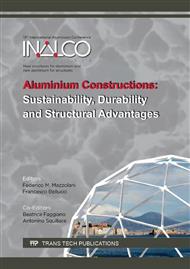[1]
M.S. Dargusch, G. Dour, N. Schauer, C.M. Dinnis, G. Savage, The influence of pressure during solidification of high pressure die cast aluminium telecommunications components, J. Mater. Proc. Tech. 180 (2006) 37-43.
DOI: 10.1016/j.jmatprotec.2006.05.001
Google Scholar
[2]
F. Bonollo, G. Timelli, N. Gramegna, High Pressure Die Casting: Contradictions and Challenges, J. of Metals 63 (2015) 901-908.
DOI: 10.1007/s11837-015-1333-8
Google Scholar
[3]
E. Battaglia, F. Bonollo, G. Timelli, E. Fiorese, G. Kral, Correlation between process, microstructure and properties in High Pressure Die Casting Aluminum-Silicon alloys, Proc. AMPT2015 Int. Cong., Madrid (2015).
DOI: 10.1080/2374068x.2016.1250206
Google Scholar
[4]
E. Fiorese, F. Bonollo, E. Battaglia, G. Cavaliere, Improving die casting processes through optimization of lubrication, Int. J. Cast Metals Research (2016).
DOI: 10.1080/13640461.2016.1162387
Google Scholar
[5]
E. Gariboldi, F. Bonollo, P. Parona, Handbook of defects in high pressure die casting, second ed., AIM, Milano, (2010).
Google Scholar
[6]
CEN/TR 16749: 2014 Aluminium and aluminium alloys – Classification of defects and imperfections in high pressure, low pressure and gravity die cast products (2014) 1-41.
DOI: 10.3403/30299762u
Google Scholar
[7]
E. Fiorese, F. Bonollo, G. Timelli, L. Arnberg, E. Gariboldi, New classification of defects and imperfections for Aluminum alloy castings, Int. J. of Metal Casting 9 (2015) 55-66.
DOI: 10.1007/bf03355602
Google Scholar
[8]
Information on http: /music. eucoord. com/intro/body. pe.
Google Scholar
[9]
U. Gauermann, A. Mazzamuto, N. Gramegna, An Integrated and Intelligent Sensor Network as tool for monitoring HPDC process parameters, Proc. 6th Cong. High Tec Die Casting, Venice (2016), AIM, Milan, paper nr. 69.
Google Scholar
[10]
E. Battaglia, F. Bonollo, I. Tonello, E. Fiorese, Correlations between defect content, mechanical properties and fractographic investigation of AlSi9Cu3(Fe) alloy Reference Castings, Proc. Thermec'2016 INt. Conf., Graz (2016).
DOI: 10.4028/www.scientific.net/msf.879.193
Google Scholar
[11]
F. Bonollo, E. Battaglia, A. Brotto, G. Kral, A. Mazzamuto, Understanding quality of HPDC Aluminium alloy products from intelligent sensors network, Proc. 6th Int. Cong. High Tech Die Casting, Venice (2016), paper nr. 66.
Google Scholar
[12]
E. Zanini, S. Barison, L. Capra, G. Timelli, F. Voltazza, Microstructure and bending properties of die-casting alloys at various chromium contents, La Metallurgia Italiana 104 (2012) 3-13.
Google Scholar


